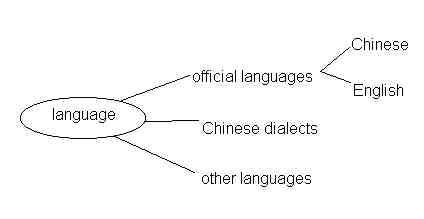
Lesson 5
Do you know...
In this lesson, you will learn:
|
J ![]()
When you are reading a
passage, it may be helpful to write down the key points. This is
note-taking.
In your notes, you don't
need to use all words. There are some ways to help you take notes.
(1)
You can use symbols and abbreviations to write your notes.
| symbols:
= is equal to / the same as ¹ is not equal to / is different from \ so, therefore ® causes, leads to > more than < less than rises, increases ¯ falls, decreases |
abbreviations:
etc. and so on i.e. that is, in other words no. number diff. different govt. government bldg building thru through |
(2) You
can use diagrams to represent the ideas
|
í ê î Hong Kong Island Kowloon the New Territories |
(3) You
can draw 'mind maps'.
 |
You may use any or all of them in your notes. Just make sure you will understand your notes afterwards.
After you have taken notes,
you can use them to write your summary. In this way, you get a better
idea of how the points are
linked, and you will
not copy exact words from the passage.
J ![]()
Sometimes you may not not need the whole passage. You only need parts of it. So, when you are reading, decide what parts you need and what parts you don't.
Read this passage.
|
The territory of Hong Kong consists of Hong Kong Island, the Kowloon Peninsula,
the New Territories, and 235 outlying islands, totalling 1,078 square kilometres.
It is situated on the southeastern coastline of China, facing the South
China Sea.
Hong Kong Island is 77.5 square kilometres. Urban areas are concentrated along the northern shore, its centre and south coast being dominated by mountains. Kowloon, although only 45.5 square kilometres, is flatter and therefore more urbanised. Containing most of the territory's land mass (955 square kilometres including the outlying islands), the New Territories is mostly rural, but has growing regional centres which are self-sufficient new towns. |
What would you include
if you are going to write about only the New Territories of Hong Kong?
Type your answer in the
box below.
Then click [Compare my
answer] button.
J ![]()
This is the last lesson
in Ghostwriter College. You have been doing so well.
Before you move on, let's
quickly re-cap some Do's and Don'ts of writing a summary.
Do's
Don'ts